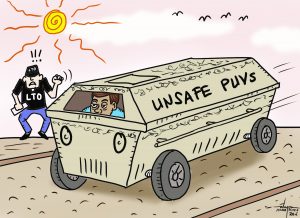BY HERMAN M. LAGON
IT WAS an emotional moment when Rynshien Joy Olivete, the managing director of Dakila Iloilo Collective, stood up after the screening of the award-winning Tumandok. Her voice shook, her words punctuated by tears, yet her message echoed powerfully across the cinema. Olivete’s speech, much like the film itself, was a passionate call to remember, reflect, and resist. “What kind of future are we building if we erase our past?” she asked, her voice trembling yet resolute. It wasn’t just a question—it was a challenge that reverberated beyond Robinsons Jaro Cinema’s walls last September.
Olivete’s moving speech following Tumandok represents the daily struggle faced by Indigenous peoples (IPs). To many, her tears may have seemed like a moment of vulnerability. But for those who listened closely, they symbolized resistance—a deep, almost painful defiance against the historical injustices that continue to oppress the Indigenous communities of Panay and other marginalized groups in the country.
As she stood there, sharing the plight of the Ati people from Sitio Kabarangkalan, Barotac, Viejo, Iloilo, it was impossible not to juxtapose her words with the film’s themes. Tumandok was not just a documentary but a voice for those whose stories are too often silenced. It was a defiant refusal to let the stories of the marginalized fade into oblivion. Directed by Arlie Sweet Sumagaysay and Richard Jeroui Salvadico, the film tells the story of Indigenous struggles in Panay through the voices of the Ati people—voices that have been historically ignored but, at this moment, were front and center.
Tumandok opened many people’s eyes. The film took viewers beyond the stage of passive spectators and made them witnesses of the terrible reality of IPs’ forced displacement, exploitation, and repression. The film’s positive critiques all point to its power in making visible what the mainstream narratives have long hidden. “It’s a work of advocacy wrapped in powerful storytelling,” said one local critic. Others lauded the film for giving the Ati people their voice, quite literally, as the cast spoke in their native Inati language. In doing so, Tumandok did more than just document a story; it lived the truth of cultural preservation through language, art, and identity.
This event, however, was about more than just Tumandok, the film. It was also about the festival itself—the 12th edition of the Active Vista Human Rights Festival. Under the “Espekulasyon” banner, this year’s theme encouraged audiences to ask bold questions and imagine new possibilities. What could the world be like if we truly listened to the voices of the marginalized? As Olivete hinted, what if we stopped erasing the past to craft a more equitable future? What if the stories we tell could alter the course of history?
The power of storytelling has been well-documented in numerous studies. The late sociologist Stuart Hall once posited that “the struggle for cultural recognition is central to political change.” It is not enough to have laws and policies; narratives shape our world and define whose lives are worth protecting. This is the space where Active Vista and Dakila Philippine Collective for Modern Heroism thrive. By creating platforms for stories that challenge the status quo, films like Tumandok encourage us to engage in acts of “speculative vigilance” to borrow from Olivete’s speech.
And that, ultimately, is what the Active Vista Festival is about—imagining the world not as it is but as it could be. Tumandok dared to ask: What if the IPs of Panay could live without fear of losing their land? What if we truly valued their rich traditions and histories rather than treating them as expendable in the name of progress? What if we all recognized that, as Olivete said, “their struggle is our struggle”?
Of course, the challenges are immense. Real-world abuses of Indigenous rights continue despite international legislation safeguarding those rights, such as the United Nations Declaration on the Rights of Indigenous Peoples (UNDRIP). Indigenous communities are frequently targeted by militarization and extractive industrialization. Although the recent administrations claimed to have achieved peace and progress, the marginalized have paid a heavy price for these purported gains. Human rights organizations such as Karapatan have reported that violence is still being used to silence Indigenous leaders, either by harassment, red-tagging, or worse.
In this context, Tumandok is not just a film but an act of defiance. As critic Luis Francia aptly noted, “Filmmaking is a revolutionary act when it captures the voices of those long silenced.” The film’s raw portrayal of injustice and resilience is not just a retelling of history but a warning and a call to action.
Much like the tradition of reflection and discernment, the film encourages us to see deeper truths, question easy answers, and ask ourselves: What are we complicit in? What does it mean to disregard the struggles of others? These questions, which are so central to the spirit of Tumandok, resonate beyond the film itself. They are questions we must all wrestle with, especially those of us in positions of influence and privilege.
The festival’s choice to feature Tumandok in Iloilo—often seen as a bastion of progress and development—was a brilliant move. It served as a subtle but firm reminder that even in spaces that pride themselves on innovation and growth, there is an undercurrent of inequality. “Not all roads lead to Megaworld,” Olivete quipped. The irony of a city sinking by 9mm a year yet building more high-rises was not lost on the audience. These are the types of contradictions that Tumandok brings to light.
Yet despite the darkness, both Olivete’s speech and Tumandok leave us with a sense of hope. It is not blind optimism but rather a hope rooted in the belief that change is possible if we have the courage to imagine it. “To speculate is to resist,” as the festival’s theme suggests. True, protests and activism are not the only ways democratic resistance manifests itself. Sometimes, it comes from being bold enough to imagine what might be possible if we upheld and embodied the principles of inclusion, justice, and equity. Our artistic pursuits, shared experiences, and the stories we tell are part of a broader movement to build a more compassionate and just world.
Thus, the next time you see a movie like Tumandok, do not just watch—engage. Ask yourself the hard questions. Imagine alternatives. And, as Olivete reminded us through her tears, never forget that every story told is a step closer to the future we all deserve.
***
Take advantage of your chance to experience Tumandok! Catch this powerful and moving film, and join in the thought-provoking discussions it sparks on October 4 and 5 at Cinematheque Center Iloilo, G/F B&C Square Building, Solis St, Iloilo City Proper, Iloilo City, Iloilo. If you have not seen it yet, now is the time to engage in a movement for justice and equity. Be part of the change.
***
Doc H fondly describes himself as a “student of and for life” who, like many others, aspires to a life-giving and why-driven world grounded in social justice and the pursuit of happiness. His views do not necessarily reflect those of the institutions he is employed or connected with.


